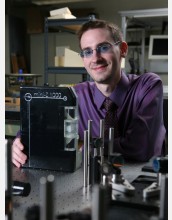News Release 07-092
Young Inventors' Research Transforms the Marketplace
Interdisciplinary study gives birth to new products and processes; August is National Inventors' Month
August 3, 2007
This material is available primarily for archival purposes. Telephone numbers or other contact information may be out of date; please see current contact information at media contacts.
What do a portable imaging device, a material for cardiac stents and a process for creating strong and flexible plastics have in common? All are inventions that have been developed by trainees in the National Science Foundation's (NSF) Integrative Graduate Education and Research Traineeship Program (IGERT).
IGERT is an NSF-wide program that was developed to meet the challenges of educating U.S. scientists and engineers who will pursue careers in research and education. It aims to bring together interdisciplinary backgrounds, deep knowledge in chosen disciplines, and technical, professional and personal skills that will build leaders and creative agents for change.
Brian Schulkin, an IGERT trainee participating in a project called "Terahertz Science and Technology--a Studio-Based Approach" at Rensselaer Polytechnic Institute, won the first-ever Lemelson-Rensselaer $30,000 student prize for inventing an ultralight, hand-held terahertz spectrometer. The device has applications in medical, aerospace, security and other fields. Terahertz rays, or "t-rays" are based on the part of the electromagnetic spectrum that is defined by frequencies from 0.1 to 10 terahertz--just between infrared light and microwave radiation. Though they can pass through clothing, wood, plastic and other materials, t-rays are not harmful to health in the way that x-rays are. Until now, a major challenge has been the size and weight of t-ray devices.
Schulkin successfully developed a system approximately the size of a laptop computer. Dubbed the Mini-Z, it does not require any peripheral equipment. The Mini-Z has already proven its ability to detect cracks in space shuttle foam, image tumors in breast tissue, and spot counterfeit watermarks on paper currency.
Nanotechnology, chemistry and engineering come together in Blake Branson's work at the Interdisciplinary Program for Research and Education in the Nanosciences project at Vanderbilt and Fisk Universities.
Branson has patented a new process for creation of composite materials that are hard, strong and relatively lightweight. The process uses chemistry to disperse nanoscale diamond particles into various plastics. The exceptionally hard and stiff diamond particles enhance the material properties of the plastics. Mechanical tests have shown the new material to have increased tensile strength and stiffness as well as increased hardness even when the diamond particles make up only a small fraction of the composite material's weight.
Possible applications for the process include the manufacture of improved safety goggles and panels in armored vehicles. Not only can more protection be provided without adding additional weight, but the use of nano-diamond is potentially much more economical than other nano-carbon fillers such as carbon nanotubes.
Lisa Kemp and Nick Hammond are participants in a joint IGERT project at the Universities of Mississippi and Southern Mississippi called "Entrepreneurship at the Interface of Polymer Science and Medical Chemistry." They have worked on "bio-transformable" materials that could be implanted in the body and provide controlled release of medications. The materials are intended to provide rigid support initially, followed by a transformation into a flexible material that closely mimics the physical properties of the surrounding natural tissue.
Among other applications, these materials would address the shortcomings of existing technology for cardiac stents, whose current design carries a risk of clotting and clogging (thrombosis). Kemp and Hammond created a business plan for which they won a second place award in the National FedEx Technology Business Plan Competition last year. The company they created, Ablitech, Inc., is currently funded by a Phase I NSF Small Business Innovation Research grant, and two patents are being filed for the technology.
"I owe a lot to the IGERT program and the different disciplines it brings together," says Kemp. "We may have different languages and think differently about the science we do. But now we can communicate and be more innovative than we would have been individually."
Since its inception in 1998, NSF has granted to proposing university faculties a total of 196 IGERT awards, each of five years duration. The awards enable these universities to offer stipend support and tuition allowances to graduate students to engage in research and educational training in critical interdisciplinary areas of science and engineering.
-NSF-
Media Contacts
Maria C. Zacharias, NSF, (703) 292-8070, email: mzachari@nsf.gov
Program Contacts
Judith Giordan, NSF, (703) 292-5038, email: jgiordan@nsf.gov
Related Websites
IGERT program page: http://www.nsf.gov/funding/pgm_summ.jsp?pims_id=12759
The U.S. National Science Foundation propels the nation forward by advancing fundamental research in all fields of science and engineering. NSF supports research and people by providing facilities, instruments and funding to support their ingenuity and sustain the U.S. as a global leader in research and innovation. With a fiscal year 2023 budget of $9.5 billion, NSF funds reach all 50 states through grants to nearly 2,000 colleges, universities and institutions. Each year, NSF receives more than 40,000 competitive proposals and makes about 11,000 new awards. Those awards include support for cooperative research with industry, Arctic and Antarctic research and operations, and U.S. participation in international scientific efforts.
Connect with us online
NSF website: nsf.gov
NSF News: nsf.gov/news
For News Media: nsf.gov/news/newsroom
Statistics: nsf.gov/statistics/
Awards database: nsf.gov/awardsearch/
Follow us on social
Twitter: twitter.com/NSF
Facebook: facebook.com/US.NSF
Instagram: instagram.com/nsfgov



